|
Workshop
The aim of the workshop was to get an insight into the strategies of catalogue and theoretical writing and the typologies of texts that accompany exhibitions. The focal point of analysis was the text in the exhibition catalogue that would be dealt with from historical, contextual (relation, exhibition, spectator, society) and validating point of view. We will also determine its significance in the process of establishing and institutionalising of contemporary artistic practices. We will seek to find out to what extent contemporaneity is dependent on its definitions as well as what is the relation between the exhibition catalogue and the literary theoretical work, which contemporaneity bequeaths to history.
Schedule
April 13 (Friday)
10.00-11.30 Introductory lecture
A Voice of One’s Own: catalogue text as an example of performative writing
Catalogue text is a piece of interdisciplinary and performative writing. Most importantly each exhibition has a certain concept that needs to be clarified with the catalogue essay. However, there are other requirements that a thorough catalogue essay needs to fulfil. On the one hand, many relevant data need to be clearly presented throughout the text so often takes a long research to collect and select the necessary information. On the other hand, the catalogue text is a text after all so each writer has to find his/her own voice through the process of writing.
Therefore the writing of the catalogue text happens by a performative entanglement of these three radically different aspects: the extrapolation of the concept, collecting and analysis of necessary information (about the works, or issues related to the exhibition) and the personal quest for one’s own unique voice (of the writer/curator).
Theoretical concepts, literature and certain creative writing methods can help the writer in finding the appropriate writing approach for each exhibition and catalogue text. However, I want to argue that the catalogue text is a unique genre that is neither only theoretical text, nor just another literature genre. It is also far from pure description or retrieval of the artistic concepts and expressions. Therefore even though it is open to experiments and variability there are certain specific rules of this genre and only by following these rules it can justify its existence.
12.00-13.30 Sub-genres of Catalogue Texts
The already existing different exhibition models (individual, monographic, retrospective, thematic, historicised, or biennial international exhibitions), as well as the recent development of different exhibition models (on-line, collaborative, participatory, etc.) require re-thinking of the genre itself.
The main questions of this session are how should one adapt and change the writing methods, forms, vocabulary, etc., when writing different texts and how this affects “one’s own voice.”
13.30-15.00 Break
15.00-15.30 Preparation of the close reading workshop
Organisation of the order of reading of different textual samples, forming groups of participants according to the chosen texts, etc.
15.30-17.30 Close reading workshop
The questions that in the previous session had been tackled generally and theoretically during this session will be exemplified on some samples of the proposed texts. The texts for the session of close reading will be available to the participants in advance and they are asked to choose one text each for the close reading session.
Samples of catalogue texts available for reading and selection (at SCCA-Ljubljana):
- Marina Abramovic, Oxford: Museum of Modern Art – Oxford, 1995 (monographic exhibition).
- Archipelago, Stockholm: Cultural Capital of Europe, 1998 (group international project).
- Manifesta 2 and 4v, Luxembourg, 1998 and Frankfurt, 2002 (International Biennial).
- Capital and Gender, Skopje: Museum of the City of Skopje, 2001
- Eternal Recurrence 4, Skopje: Press to Exit project space, 2006 (individual project).
-
Interrupted Histories, Ljubljana: Moderna Galerija, 2006 (research project and exhibition).
-
Correspondences, IFA – Berlin, Bonne, Stuttgart, 2001 (kcuratorial exhibition).
18.00-19.00
Q/A session about the assignment: Discussion about the specific issues related to the writing of the text required for the last day of the workshop.
April 14 (Saturday)
10.00-14.00 Presentation of the written texts
14.00-15.30 Break
15.30-17.30 Division in groups and discussion of the written texts
17.30-19.00 Groups get together and present their remarks and conclusions
The workshop was led in English language.
Participants:
Ivana Bago (1979)
Born in Mostar. She received her degree in Art History and English Language and Literature at the Faculty of Philosophy in Zagreb. In 2004 and 2005, she attended the Course for Curators (SCCA -Ljubljana). She is one of co-founders of the independent organization Katapult 6 in Ljubljana. She also collaborates with the independent institution KONTEJNER – the Bureau for Contemporary Art Practices (www.kontejner.org). She works as Assistant Curator in the Gallery Miroslav Kraljević in Zagreb (www.miroslav-kraljevic.hr).
Ida Hiršenfelder (1977)
Born in Kranj. In 2004/2005, she has completed the Course for curators (SCCA- Ljubljana). Since 2002, she is active as curator and co-curator within the frame of various exhibition projects (The Long March, Between Realism and Utopia, Neatly Dirty, China Soiree…). She organised or co-organised several international projects (Chinese Culture Month, Ljubljana; the seminar Too much flavour, Shanghai; www.orozje.com). She is publishing texts in various publications. She lives and works in Ljubljana.
Vid Lenard (1974)
He received his degree in Art History at the Faculty of Arts in Ljubljana.
Maja Lozić (1979)
Graduated in Art History in Ljubljana. Since 2007 collaborator of Center and Gallery P74.
|
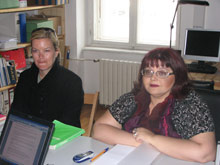
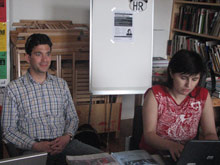
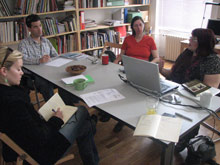
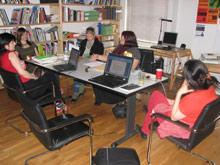
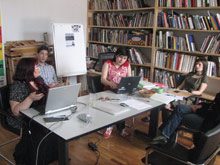
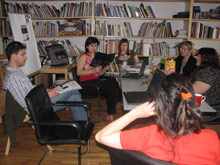
|






